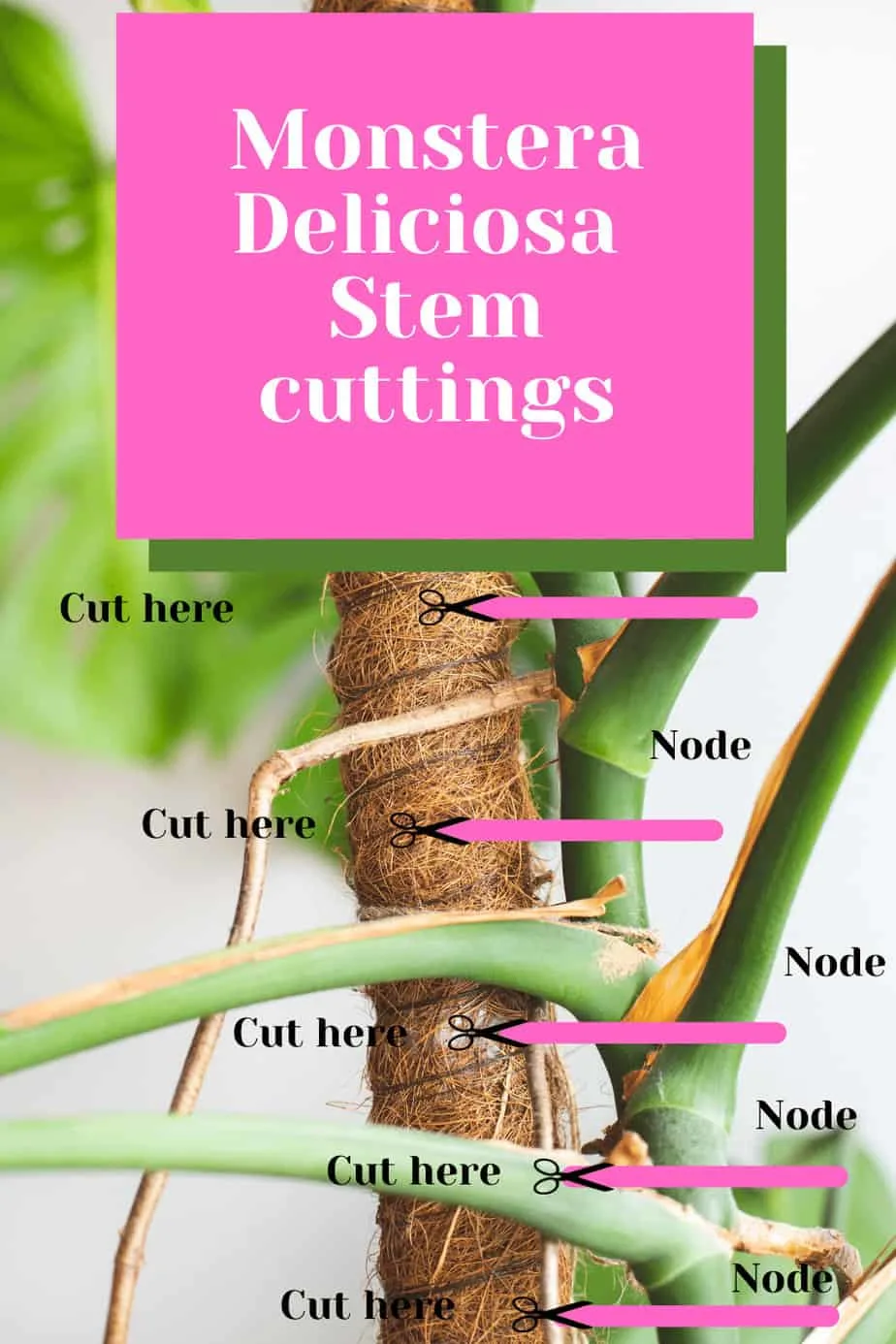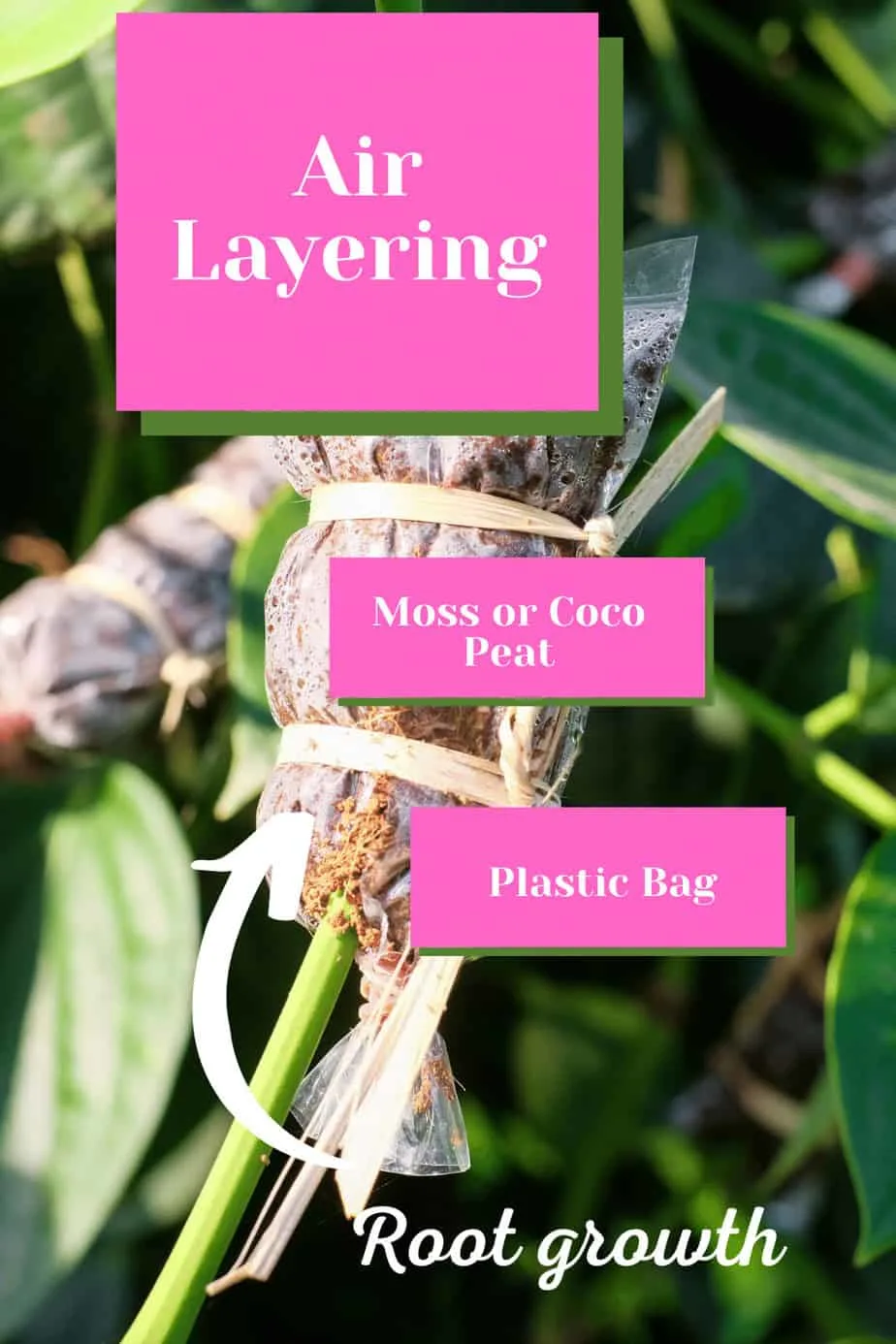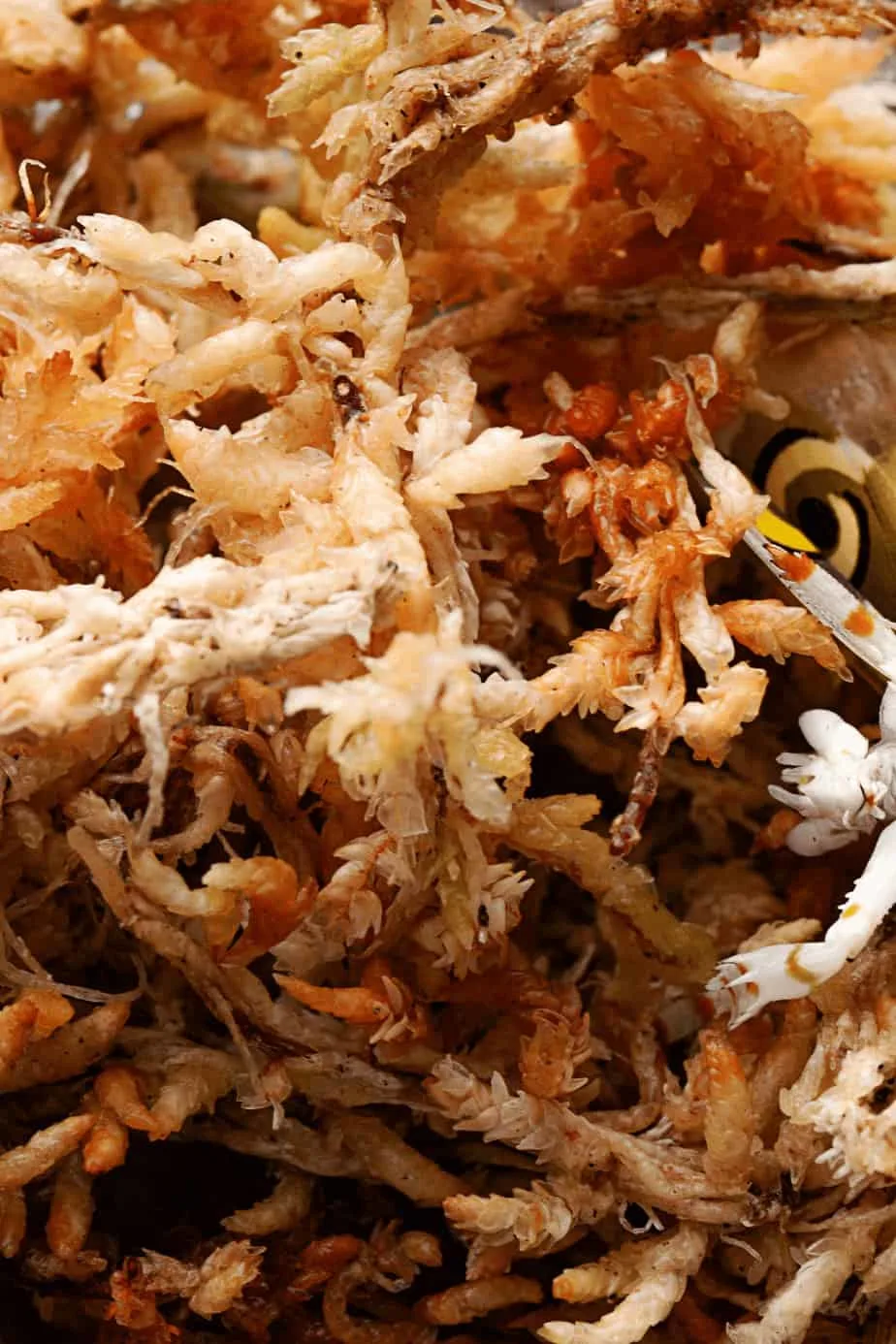How to propagate Monstera deliciosa. If you have a Swiss Cheese Plant and want to multiply it, this guide is for you.
I propagated many Monsteras. You can do it in multiple media such as water, soil, Sphagnum moss, and perlite.
What is crucial is that you are cutting the plant in the right area. Monstera deliciosa needs at least one node. The node contains all the information necessary for cloning.
Table of Contents
How to Propagate Monstera deliciosa plant?
To propagate the Monstera plant, cut off a stem segment with at least one node and 1-2 leaves. Make a slit directly below the node, and plant the cuttings in a container with water. Ensure that sufficient sunlight reaches the plant. Within several weeks root growth starts. You can then transplant the cutting to a growing medium.

Rooting Monstera cuttings
Monstera cuttings can either be rooted in water, soil, leca, pumice, or Sphagnum moss. The main difference is the roots that form.
True soil roots form if your cuttings are put in the soil directly. The benefit is that there is no transfer shock. The disadvantage is you cannot observe root growth. The chances of success are also lower compared to other methods.
How to propagate Monstera deliciosa in Water
Water propagation is my favorite method to propagate the Swiss Cheese plant. The main benefit is that you can observe what happens. You will see once the roots are starting to grow.
Here is how to do it:
- Get scissors, pruning shears, or a knife
- Disinfect the blades using rubbing alcohol or a flame
- Cut below a node (1-2 leaves are preferred for faster growth, but not necessary)
- Wait for 30 minutes for the cutting to callous over
- Add the cutting into a vase but ensure the leaves stay dry
- Exchange the water daily
- After 2-3 weeks, roots start to form
- Once the roots are 4 inches long (10.6cm), transfer the cutting to potting mix
Monstera deliciosa Propagation Methods
There are a few things that you need to know about Monstera propagation. Cuttings are only one way to propagate this houseplant. Other ways are seed propagation, cloning, or air layering. You can also start with seedlings.
Monstera deliciosa cutting
The cuttings themselves have to consist of a node. The node is the chubby part of the stem. Cuttings need to be taken from the stem. Leaves and petioles alone do not contain the necessary information to turn into a plant.
The cuttings will be wet after the cut. Plant sap and water are escaping from the opening. They might rot if you immediately place the cuttings into water or soil.
Therefore you have to wait for the cuttings to dry. The thicker the stems, the longer they are called over (dry).
Usually 30min. are sufficient based on my experience. I also add charcoal, which closes the wound better and has antibacterial properties.
You can use rooting powder if you want. It is not necessary.
The propagation process is faster if you have several leaves on your cutting. Your cutting can continue to photosynthesize.
How to propagate Monstera deliciosa without a Node
You cannot propagate a Monstera without a node. Indoor plants such as Hoyas or Begonias can be propagated from just leaves. The Monstera genus does not belong to this plant category.
Plant leaves and petioles might produce some roots after a while, but they will not turn into a new plant.
Propagating Monstera Deliciosa Through Stem Cuttings
1. Look for a Node
When you take cuttings from your Monstera Deliciosa, you must ensure it is done close to the node.
The node is a little nub on your plant stem and is the only way to propagate your plant.
The node is the area from where the new shoot will sprout. It looks like a small bump or pimple on the plant near the petiole intersection.

2. Cut the Stem
Cut your stem below the node with sharp shears or a knife. Make sure that the stem has a few leaves present on it.
Once you have snipped off the stem, take the cutting and wash it with filtered water.
3. Cut Off Extra Leaves
If there are excess leaves present on the stem, then you must snip them off. Your stem should have no more than two or three leaves present on it.
Ensure that the excess leaves are not cut from the top area of the stem.
4. Place Your Cutting in Water
Take a glass jar and fill it with filtered water that is at room temperature. Place your plant cutting in the glass jar.
5. Position Your Cutting
Place your Monstera deliciosa close to a window to receive bright, indirect sunlight.
Never place your plant under direct sunlight, as it can burn the leaves.
Within 2-3 weeks, either new roots or new leaves (a new leaf) will form. Generally, roots form first.
The roots will be water roots. Water roots are white, whereas soil roots are brown. Once you transfer your cutting to the soil, the water roots will transform into soil roots. This can shock the plant temporarily.
Closely observe your plant during this transition.
Propagating Monstera Deliciosa Through the Air Layering Method
This propagation method is best if you want to ensure to have roots are ready before you take a cutting.
To successfully propagate your Monstera Deliciosa, use a sharp knife or cutting tool, a toothpick, sphagnum moss, and clear plastic.

1. Examine Your Monstera Deliciosa
Examine your Monstera deliciosa to find where you want the new plant’s roots to grow.
Choose a spot six inches below an area where leaf growth occurs.
2. Make A Cut
Use a sharp and sanitized blade. Start making an upward diagonal cut one-third of the way through the stem.
3. Insert the Toothpick
Insert a toothpick sideways into the stem cutting so it remains open through the rooting process. You can apply rooting hormone to help speed up the process, but this step is unnecessary. they contain auxin. Auxing promotes the growth of adventitious roots.
4. Add the Sphagnum Moss
Take a handful of sphagnum moss (make sure it is moist) and tie it around the stem, cutting with the help of the twine.

5. Using the Plastic Bag/ Sheet
Take the plastic bag or plastic sheet, and tie it around the ball of sphagnum moss; this will help it retain moisture.
6. New Roots
Once new roots develop in a few months, remove the plastic around the sphagnum moss and make a small cut through the stem, just below the new growth.
Plant your Monstera deliciosa into a pot with drainage holes. Remove the moss from the roots before you plant the cutting.
Add aroid soil using chunky bits. Drainage and airflow to the roots are essential. Without sufficient oxygen, root rot develops.
Replanting can result in shock. If the bottom leaves turn yellow, it could be a sign that your plant is in shock.
Factors That Effect Propagation Success for Monstera Deliciosa
Time of the Year
You do not need to set a specific time to take cuttings from your Monstera Deliciosa.
However, it is important to remember that propagating your plant in autumn and winter will cause slower growth since most plants are dormant in that season.
Temperature and Light
Monstera deliciosa cuttings grow best in warm and bright areas.
Compared to low light, your plant will grow faster if kept under bright indirect sunlight.
You can use a heating pad in colder areas, as it has been proven to speed up the propagation process.
Moisture
When propagating your Monstera deliciosa directly in the soil, you must ensure the soil is moist and not wet.
If the soil is kept wet, then the roots of your plant will rot.
Feel the soil at least once weekly and see if it feels slightly dry.
Only if it is just slightly dry should you consider watering it again.
Many growers suggest covering the cut stem with a plastic bag to increase the humidity when propagating.
This is a neat way to increase humidity, but you will ensure the air does not become stagnant.
So lifting the plastic from the stem every couple of days is advised.
Cutting Size
Stems that are longer and have more growth points have a higher chance of success.
This is important for Monstera deliciosa since it is a climbing plant and grows on one long stem.
If your cutting has several leaf sprouts on multiple nodes, there are more chances for your cutting to grow into a new plant.
But usually, only one node will develop new growth.
Many may start, but the energy in the cutting is usually only sufficient to maintain one new growth point, and the rest will be abandoned.
Growing Medium
Initially, choosing water as your propagation medium is the best option since you can see the new growth and roots immediately.
But larger cuttings with leaves and aerial roots propagate better in soil.
Spaghnum moss and perlite are also viable alternatives.
Here is an article about the best soil for Monstera deliciosa.
Choice of Water
You can place your cuttings in tap water, but if your tap water is hard, do not use artificially softened water.
Your best option is to use rainwater or distilled water.
Soil Mix
Use light, free-draining potting compost for your Monstera Deliciosa as it ages.
Ensure the soil’s pH is between 5.5 to 7.0 (slightly acidic to neutral).
The most efficient and easiest way to pot your cutting is by placing the stem one inch deep and vertically into the soil.
Your stem node does not need to be above the soil, as the new leaf growth will eventually push to the surface.
But also a horizontal placement and laying your stem above ground usually works well.
Taking Care of a Newly Propagated Monstera Deliciosa
Here are some general tips about how to care for your newly propagated Cheese plant.
Light
The first thing to consider while growing a Monstera deliciosa plant is to place it in a well-lit room. Your plant must receive a daily dosage of indirect sunlight. Indirect light is sufficient. Avoid direct light for more than 3-4 hours in the morning.
At the same time, large amounts of bright sunlight can scorch the leaves and turn them yellow.
You have to maintain a delicate balance between sunlight and shade. A good tip would be to increase sunlight exposure gradually.
You can do this by placing the plant in the morning light for a few hours and bringing it inside when the afternoon sun comes out.
Temperature
The ideal temperature range for a Monstera is between 77 to 85 degrees Fahrenheit (25 to 29.4 degrees Celsius).
Water
When growing a Monstera Deliciosa plant, people often make the mistake of overwatering. Overwatering causes the soil to get waterlogged and roots to rot.
Water only once the soil is almost dry once a week.
Soil
Use a well-draining potting soil mix using peat moss, perlite, charcoal, and potting soil. Avoid dense soil. It gets soggy when watered.
An alternative is a soilless medium such as leca. I have great success with leca. The big difference is that you need to fertilize more frequently. Leca itself does not contain any nutrients.
Correct soil and water care become relevant once you shift your cutting to the soil.
Fertilizer
Make sure that you also fertilize the soil. Your plant needs appropriate nutrients to grow well and appear healthy.
However, over-fertilization is severely harmful to the plant. You should only fertilize the soil twice yearly, once in summer and spring.
Frequently Asked Questions
Why should l propagate my Monstera deliciosa plant?
It encourages the plant to grow healthier. And also gives you the liberty to direct its growth in a manner that suits you best.
Why are my Monstera deliciosa plant cutting not growing?
There is a chance that the initial cutting was not from a part of the plant that is viable for propagation. Ensure that you cut below a node.
When should I propagate my Monstera deliciosa?
Spring or Summer are considered the best seasons to propagate Monstera Deliciosa. This is when it goes through a growth spurt. You can also propagate your Monstera Deliciosa in Autumn and Winter, but growth might be considerably slower, and the chances of success might be low.
Can you grow Monstera deliciosa in water?
You can easily grow your Monstera deliciosa in water, but not indefinitely, and you must take a few precautions, such as changing the water every other day. Adding nutrients will also become a necessity after a while.
What equipment should I use for propagating my Monstera deliciosa?
The essential equipment for propagating your Monstera Deliciosa is shears or a knife. You must ensure that your equipment is sharp and sanitized before making cuttings to prevent the spreading disease-causing pathogens.
Takeaway
To propagate Monstera deliciosa from a stem cutting, do this:
- Get a clean knife or scissors
- Cut below a node
- Put the cutting in water or a rooting medium
- Wait 2-3 weeks for roots to grow
- Repot in its final pot and medium

Daniel has been a plant enthusiast for over 20 years. He owns hundreds of houseplants and prepares for the chili growing seasons yearly with great anticipation. His favorite plants are plant species in the Araceae family, such as Monstera, Philodendron, and Anthurium. He also loves gardening and is growing hot peppers, tomatoes, and many more vegetables.


